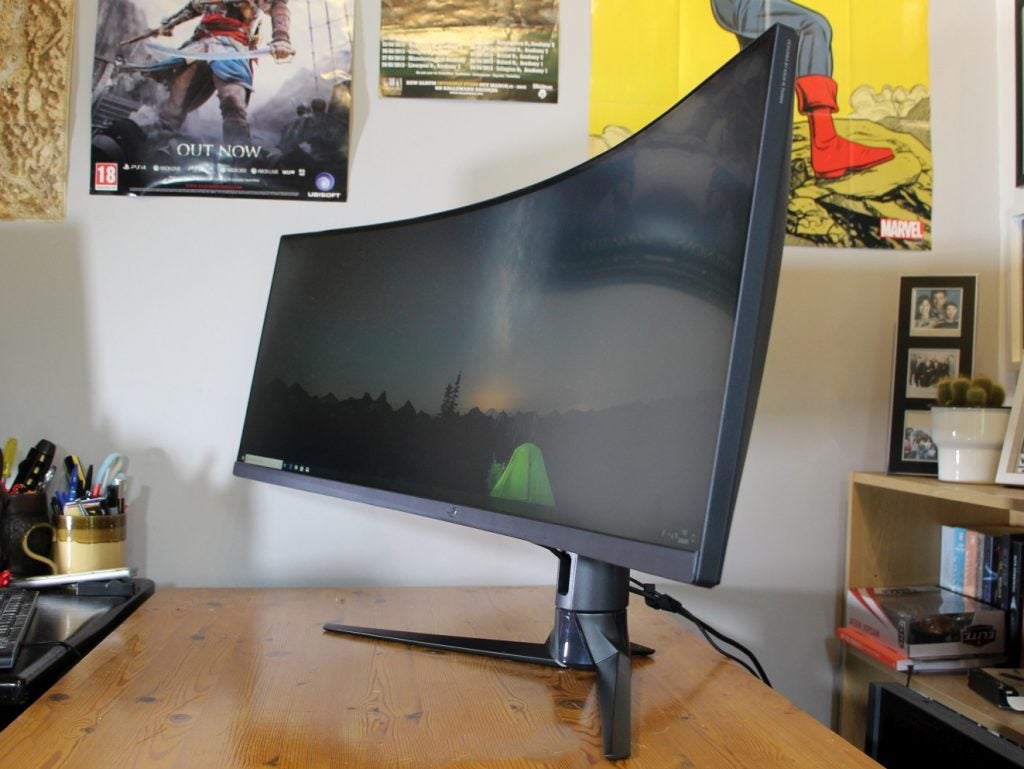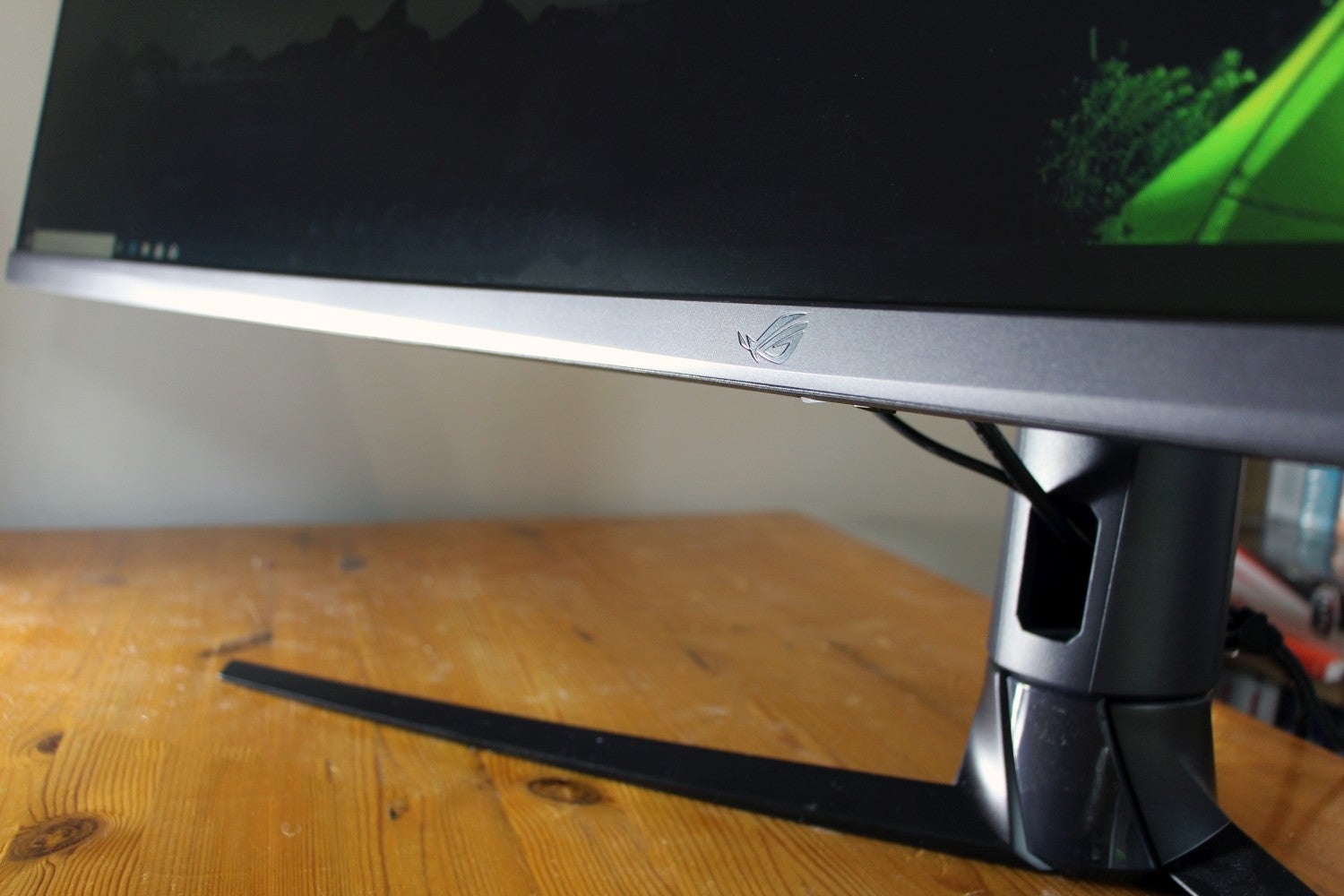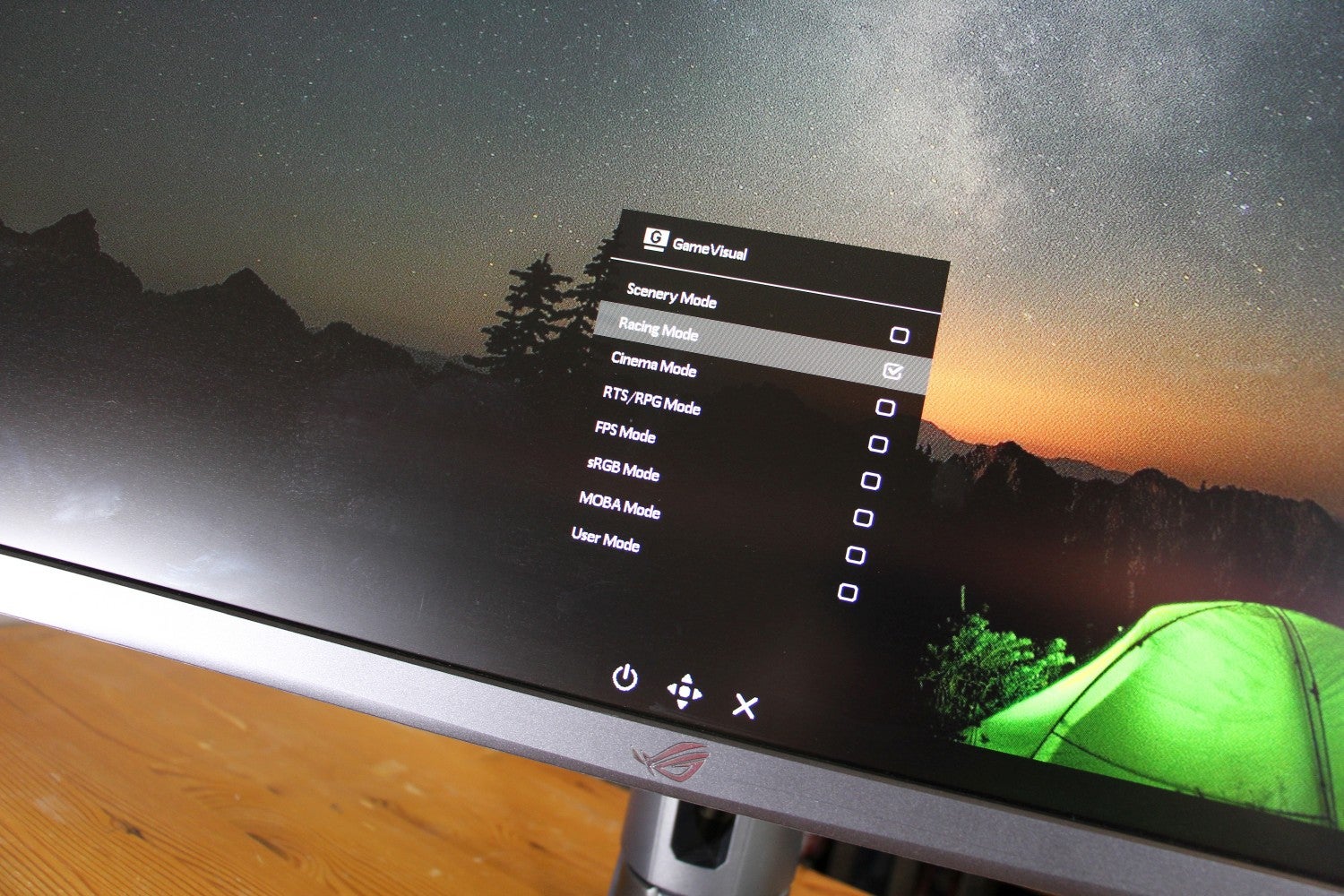Asus ROG Strix XG49VQ Review
Asus ROG Strix XG49VQ Review
The Asus ROG Strix XG49VQ is an incredible widescreen monitor for gaming – but it's expensive
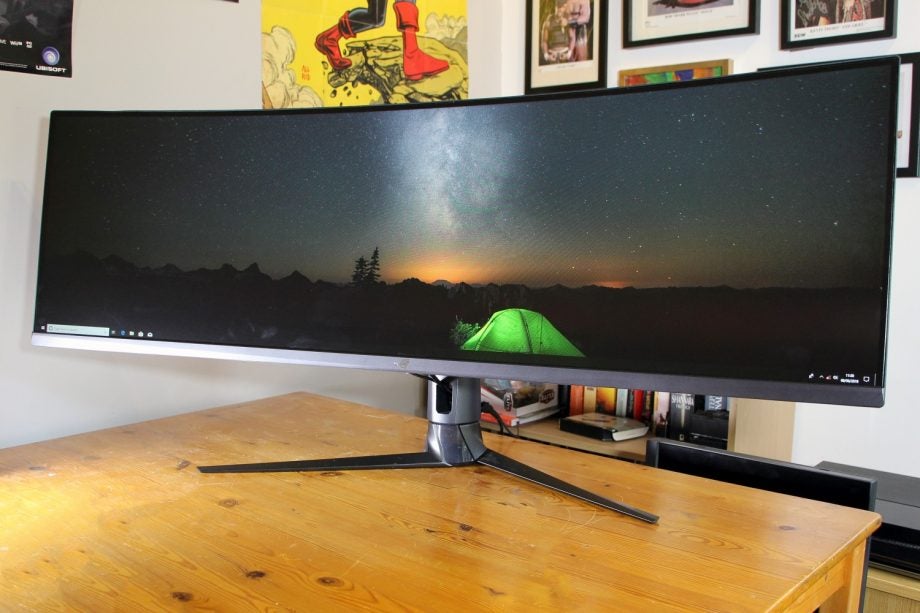
Verdict
Good basic image quality, solid design and decent features, but a high price and some inconsistent performance are issues
Pros
- Excellent colour quality
- Fantastic contrast
- Huge, curved, wide panel
- Decent physical design
- Good OSD
Cons
- Uniformity isn’t great
- HDR has little impact
- Huge price
- Limited usefulness in some genres
Key Specifications
- Review Price: £989
- 49in 3840 x 1080 144Hz VA display
- AMD FreeSync
- 2 x HDMI, 1 x DisplayPort, 2 x USB 3.0
- 4ms response time
- 2 x 5W speakers
- VESA DisplayHDR 400
- 13.3kg weight
What is the Asus ROG Strix XG49VQ?
The Asus ROG Strix XG49VQ is the latest Republic of Gamers monitor, and it’s one of the most outlandish panels the firm has ever released – not least because it has a vast 49-inch curved widescreen that will dominate any desk.
Having such a huge design is a double-edged sword – it’s great for some games, but it can be detrimental to others. And, with a price of £989, performance needs to be top-notch to justify the outlay.
Related: Amazon Prime Day 2019
Asus ROG Strix XG49VQ – Design and features
The XG49VQ uses a 49-inch VA panel with a conventional 1800R curve. The inclusion of VA technology should ensure good colours – and this is a 10-bit panel, so you’ll get the full gamut of shades from which to choose. However, VA screens don’t deliver the best response times or uniformity.
The Asus has a native resolution of 3840 x 1080 and an aspect ratio of 32:9. When combined with the 49-inch diagonal, it’s like having two 27-inch 1080p monitors sitting side-by-side. The unit looks like it wants to give you a hug.
Related: Best gaming monitor
It isn’t the first time we’ve seen a screen of this size and shape. The Samsung CHG90 has the same size, resolution and refresh rate, and it costs £919. If you need something smaller and cheaper, the BenQ EX3501R has a 3440 x 1440 resolution and a 35-inch diagonal for £625.
A more recent rival to enter the fray comes from Philips. The Brilliance 499P9H isn’t a gaming screen, so its FreeSync tops out at 70Hz, and it has only 8-bit colour. However, it offers a better resolution than the Asus – it runs at 5120 x 1440. It also costs just under £900.
Nevertheless, the Asus still offers a lot of pixels, and any widescreen involves compromise, which may mean that it isn’t suitable for your system.
Widescreens aren’t ideal for all games: they’re fantastic for racing titles, and FPS and strategy games often benefit from the extra horizontal space. However, some games feel cramped due to the lack of vertical space – the 1080 vertical resolution isn’t particularly high.
Elsewhere, some eSports titles simply won’t allow you to run at the Asus’ resolution, because it provides an unfair advantage. The screen also has a response time of 4ms, which is middling – totally fine for mainstream gaming, but not high enough for serious eSports games.
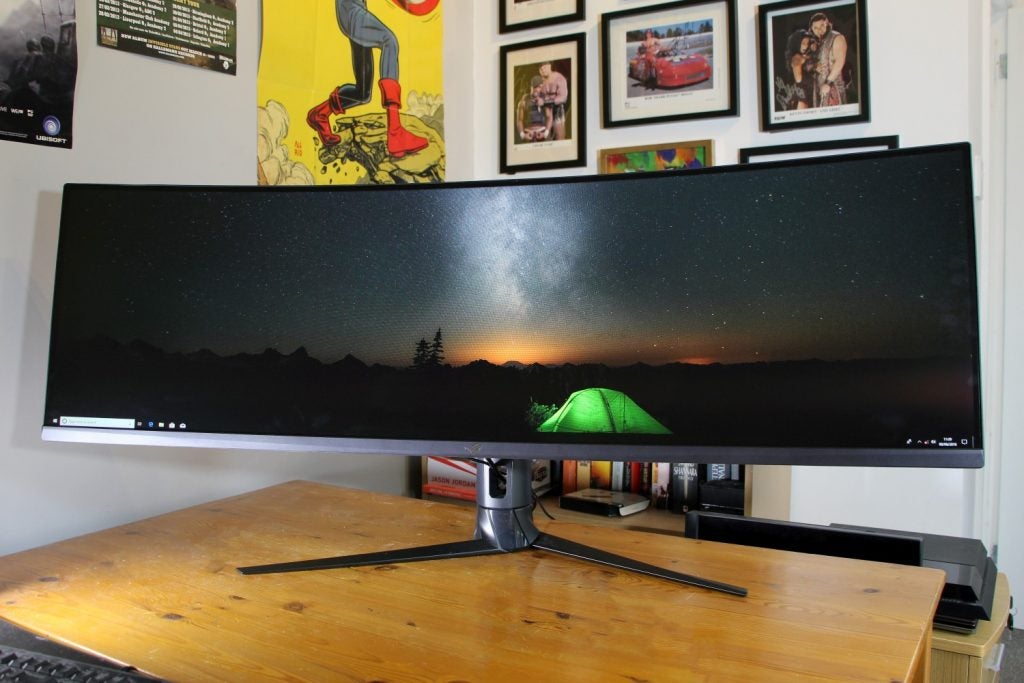
The XG49VQ’s extra-wide display looks great, but its size isn’t always a boon.
Some games may stretch artificially to fit the screen, or have trouble rendering their UI elements properly.
Most games will work without issue on the Asus screen, and in certain genres – especially racing – the width is a boon. But check the situation with specific games before you buy.
The resolution itself also has its pros and cons. The 3840 x 1080 panel is made up of 4.1 million pixels. That’s plenty, but it’s a long way short of the 7.3 million used on the Philips screen, and half as many as the 8.2 million needed for 4K panels.
The lesser pixel count means that a wider range of graphics cards will be able to run games smoothly on this screen, even with AMD FreeSync. However, the lesser pixel count also means inferior sharpness. The Asus’ density level of 81ppi isn’t high, and it means that the screen’s pixels are visible, especially if you’re sitting close. It isn’t a terminal problem, and games are crisp enough. Nevertheless, it’s worth bearing in mind if you prize higher resolutions.
A 49-inch screen at 5120 x 1440, such as the Philips Brilliance 499P9H, has a 109ppi density level, so it’s visibly crisper. 4K screens are sharper until their diagonals go beyond 40in. The BenQ EX3501R sits at 106ppi.
These issues impact on non-gaming uses, too. The 1080p height feels cramped when you’re working, and the 32:9 aspect ratio is too wide for films; much of the screen ends up unused.
Set the resolution and diagonal aside and you’ll find a screen with inconsistent features. It has the aforementioned 144Hz AMD FreeSync 2, which now works with both AMD and Nvidia GPUs.
You get good picture-by-picture options. The XG49VQ can display three different video sources at once – so, potentially, you could use the screen to display images from a games console and a couple of different PCs, or any other configuration of hardware.
With any of the picture-by-picture modes activated, however, you can’t use HDR or FreeSync – the screen is limited to 60Hz. But it’s still a versatile option.
The Asus includes HDR for normal screen operation, but it only adheres to the VESA DisplayHDR 400 standard. That’s an entry-level HDR protocol that comes with modest requirements: a long-duration brightness level of 320 nits and a burst brightness level of 400 nits.
Those brightness figures aren’t much higher than many screens without HDR, and Asus also says that the XG49VQ will hit a peak brightness level of 450 nits regardless of its HDR modes. In short, while the screen does have HDR, it will have minimal impact – and not many games have HDR modes anyway.
Elsewhere, the Asus adheres to the ROG blueprint. It sports a dramatic stand that includes handy cable-management, and the screen sits on a wide, narrow base with two legs. The bezels are slim, and build quality is good.
The speakers are impressive: the 5W units are loud, and display solid treble and high-end quality. Bass is a little weak, but they’re good enough for gaming and better than most other screen speakers.
Related: Best FPS games f0r PC
Asus ROG Strix XG49VQ – OSD and setup
It’s always tricky to assemble a 49-inch widescreen due to the panel’s sheer size, and the Asus weighs a not-so-inconsiderable 13.3kg. However, once you’ve got past the bulk it’s relatively easy to manage. All of the screws have handles, so no tools are required.
There are solid adjustment options, too. The screen swivels and tilts, and offers 120mm of height adjustment. It’s also compatible with 100mm VESA mounts.
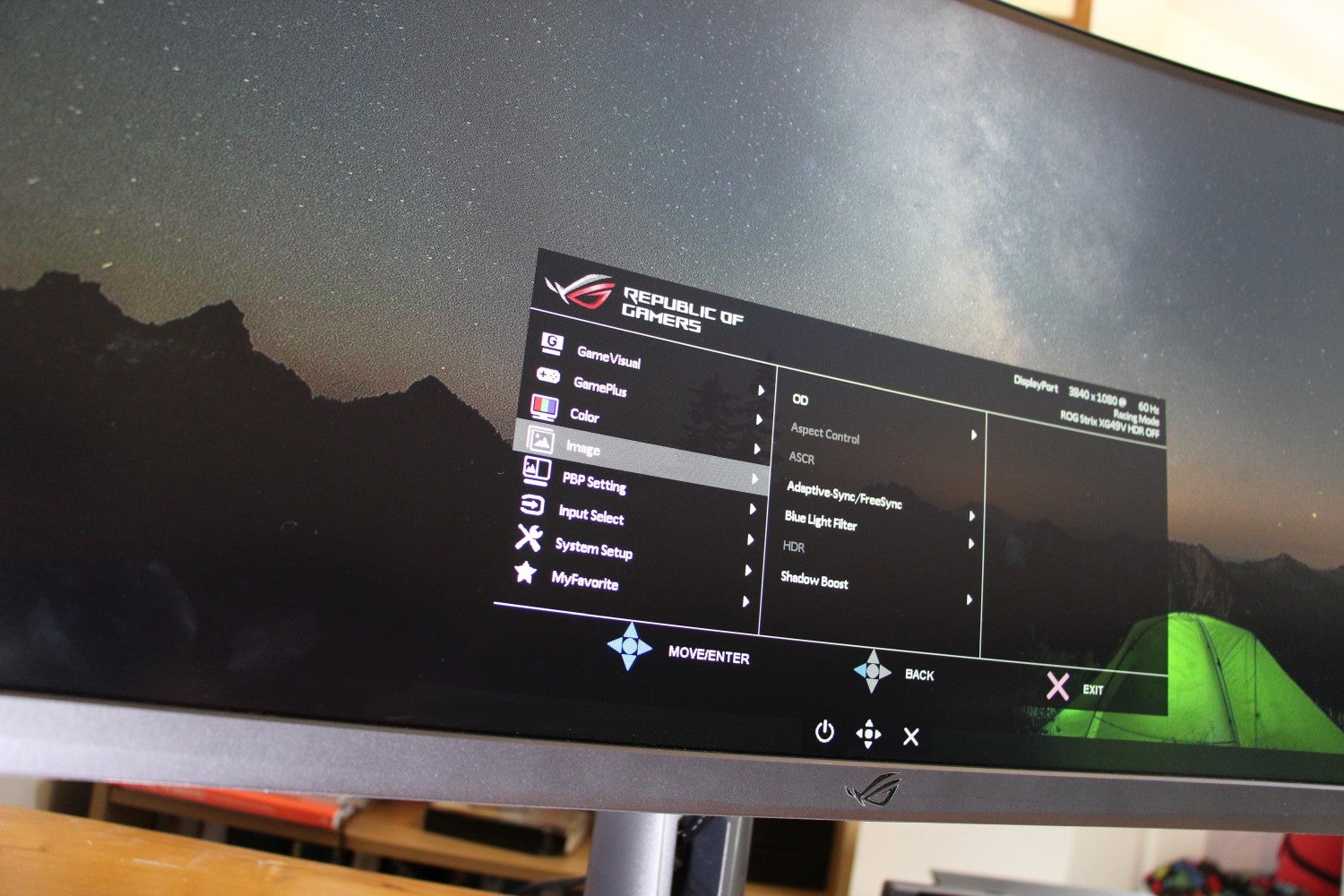
OSDs controlled with joysticks really should be the norm in 2019 – thankfully, Asus has included one on the XG49VQ.
The Asus has two HDMI 2.0 ports and a DisplayPort 1.2 connection. The panel also comes with two USB 3.0 ports and a headphone jack. Sadly, there’s no USB 3.1 connectivity, and no Type-C. The port positioning is also disappointing: none of those USB ports are installed on the side of the screen, and the connections are tricky to reach behind the stand.
The OSD is navigated with a joystick. It’s wobbly, but it’s easy to use. An initial tap brings up hotkey options. You can switch screen modes, turn on the ROG’s gaming options – including crosshairs and frame-rate counters – and adjust speaker volume.
The main menu is good; it’s large, fast and attractive. You get the usual options for tweaking brightness, contrast, gamma and colour temperature, and other menus have settings for HDR and FreeSync. There’s also a system settings menu with options to customise the hotkey options and tweak the USB ports, and all of the hotkey options are replicated in the OSD. The menu is intuitive and easy to use – if you ever need to delve in and change a setting, it’s never a chore.
Related: Best games 2019
Asus ROG Strix XG49VQ – Image quality
The Asus has good core image quality. At factory settings – when the screen uses its Racing mode – it returned a brightness of 499 nits, which is huge and better than Asus’ spec-sheet claims.
That’s too high for getting through lengthy gaming sessions without searing your eyes, but it allows plenty of versatility. It combines with a fantastic black level of 0.11 nits to deliver a contrast ratio of 4536:1.
That, again, is better than Asus’ quoted 3000:1 figure, and it means that you’re going to get incredible depth and vibrancy at every part of the colour spectrum – enough to make games pop.
The average Delta E of 2.16 isn’t far short of the point where human eyes won’t detect discrepancies, and the colour temperature of 6825K is fine – a tad cool, but not noticeably wayward.
With the screen dialled back to a more conventional 250-nit brightness, the screen maintained its impressive Delta E result. Contrast stuck at 4527:1, and colour temperature was better.
These results mean games look fantastic on the Asus XG49VQ – punchy, vibrant and bright. It beats rivals; the BenQ couldn’t compete in any area. The Samsung had better Delta E and colour temperature figures, but the difference between the two is minor and the Asus has far better contrast.
The Asus displayed 99.3% of the sRGB colour gamut, which is excellent and absolutely fine for any game.
It’s all great so far, but the Asus started to disappoint when I considered its HDR abilities. For starters, the panel displayed only 81.8% of the DCI-P3 gamut. That’s short of the 90% claimed by Asus, and it means that the screen won’t display the full range of colours for HDR.
Brightness is also an issue. While the Asus XG49VQ’s factory brightness level easily met the VESA DisplayHDR 400 standard, using the panel’s three HDR modes saw those results decline – along with contrast results, too.
In the Cinema and Gaming HDR modes, the AXG49VQ’s brightness hovers around 300 nits and the contrast sits around 2350:1. Using the FreeSync HDR mode reduces the brightness and contrast levels to 232 nits and 1845:1 respectively.
Those brightness figures don’t meet VESA DisplayHDR 400 standards, and they mean that HDR will have a limited impact here. Content will still look bright and punchy, since the benchmark results displayed here are still great in the wider market – and it will give you a benefit when compared to running the screen at lower levels of brightness. You’ll get a small boost to punch and vibrancy here, but it isn’t going to be a transformation.
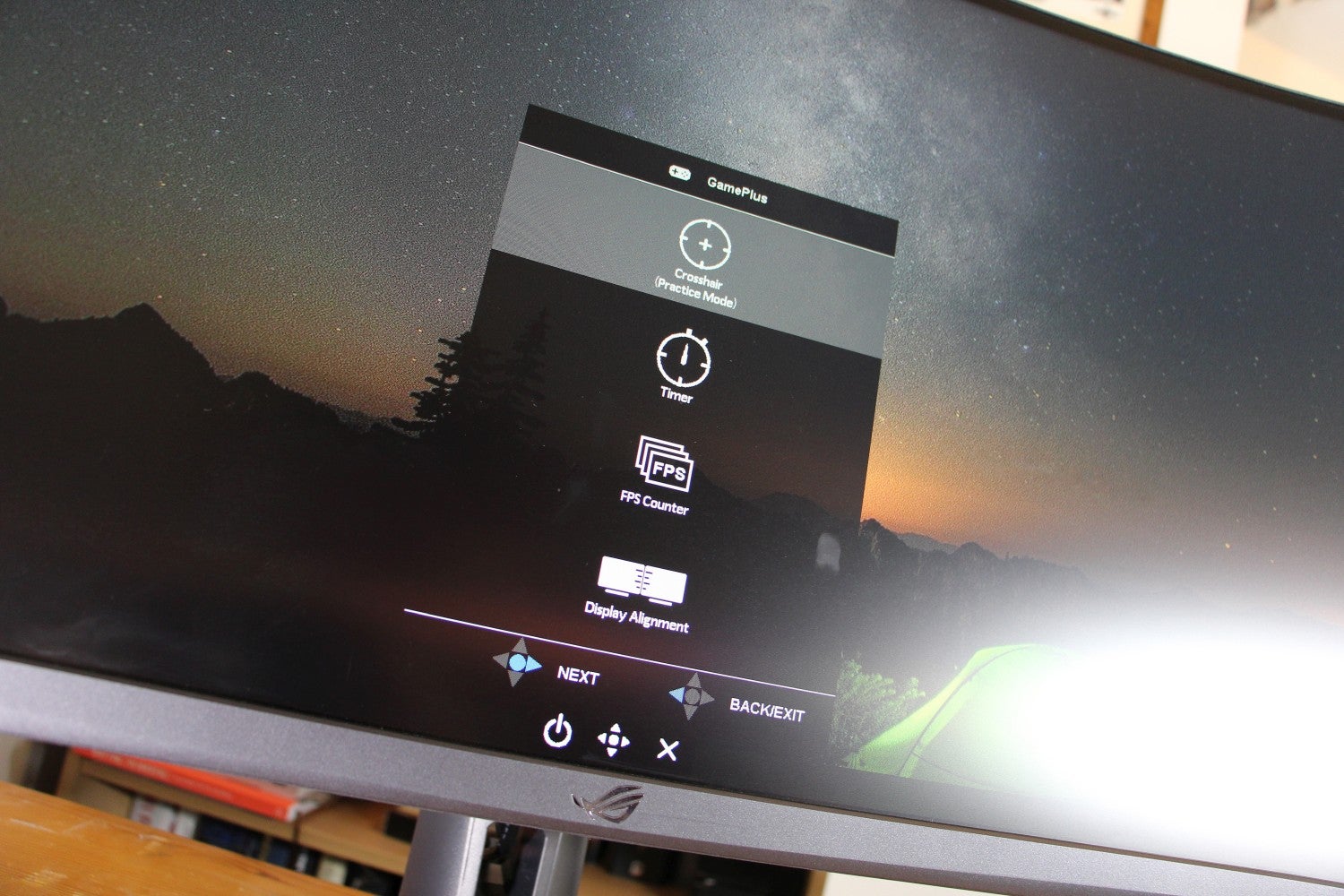
The XG49VQ offers a number of specific game display modes, but all of them pale in comparison to the HDR modes.
It isn’t all bad news, though, because the three HDR screen modes do offer some surprising advantages. As well as having great contrast by normal standards, they all deliver sub-2 Delta E levels, and all of them have colour temperatures that are very close to the 6500K ideal. That’s better colour quality than the Asus XG49VQ’s factory performance.
This means that those HDR modes are still worth looking at, since they still have great contrast and colour quality. As long as their use doesn’t hinder your games, you’ll be good to go.
The HDR modes are the only screen modes worth using. The FPS mode ramps the backlight up to 0.44 nits, which drops the contrast to a middling 1101:1 – so the screen highlights darker areas but lacks depth, which makes games look flat. The RTS/RPG mode is the same, and the MOBA mode ruins the Delta E and makes the screen look almost monochrome. The Cinema option is too blue and too cool.
Uniformity tests reveal that Asus XG49VQ has fallen foul of a familiar widescreen problem: maintaining accuracy across such a vast screen.
Down both of the XG49VQ’s edges, with the screen at full brightness, the screen lost around 17% of its backlight strength. In the corners that figure rose to 25%. Delta Es also became worse in these areas: down each edge the screen’s average Delta E deviated by 5 points, and in the corners the Delta E deviations almost hit 7 points.
These brightness and Delta E results have real-world implications. The decline in brightness is visible along the edges of the screen, and particularly in the corners, when brighter shades are being displayed. The Delta E results mean that colours are worse, too. When the screen is white in the centre, the edges and corners look grey-blue.
It isn’t a good bill of health for the Asus, but this isn’t a huge surprise. Happily, there are mitigating factors. The curve helps, and the brightness and colour variations won’t be noticeable in darker games, or when there’s a lot of action on-screen. And if you reduce the brightness levels to make the screen more palatable, then the uniformity deviations will have less visible impact too.
Related: Best multi-room speakers 2019
Why buy the Asus ROG Strix XG49VQ?
The Asus ROG Strix XG49VQ has several good attributes. Contrast and colour accuracy are great, the widescreen format helps in several gaming genres, and the lower resolution means more GPUs will be able to run this screen properly. You’ve got AMD FreeSync, good build quality and solid adjustment options. Even the speakers are impressive.
However, HDR has little impact, connectivity could be better, and not all games benefit from a widescreen. The resolution means the screen isn’t particularly crisp, and uniformity is quite poor. Those are problems that we don’t necessarily expect when a screen costs £989 – more than any of its rivals.
If you can cope with those issues and have plenty of money to burn then the Asus is a good option for fans of particular genres – especially as a result of its gaming features and, potentially, due to the lower resolution too. However, there’s no denying that this monitor has noticeable flaws, and it just won’t suit the majority of gamers.
Verdict
The Asus makes a huge first impression thanks to its 49-inch design, and it offers good gaming features, stonking contrast and solid colour accuracy – for racing games and certain other situations, it will work a treat. However, it will prove restrictive in other titles, and its minimal HDR impact, uniformity issues and lesser resolution are all potential issues. It’s expensive and only suitable for a handful of gamers.


